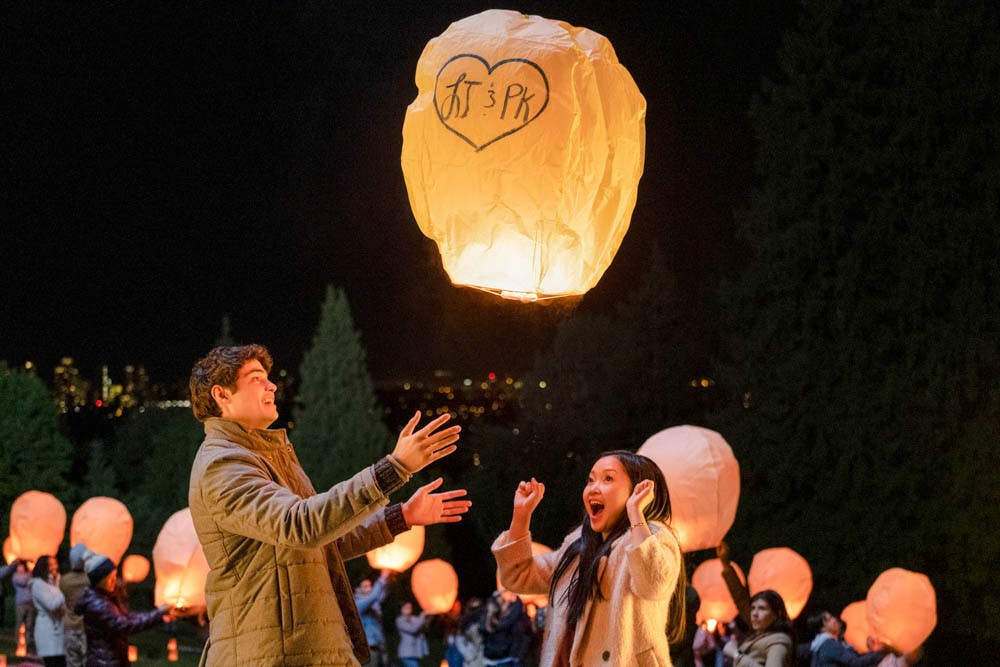On Feb. 12 — just two days before Valentine’s Day — Netflix released “To All the Boys: P.S. I Still Love You,” the sequel to the sensational 2018 rom-com “To All the Boys I’ve Loved Before.”
The film adaptation roughly parallels the second book of author Jenny Han’s trilogy “To All The Boys” and picks up right where the original Netflix installation left off.
Having just DTR-ed (“defined the relationship”), Lara Jean (Lana Condor) and Peter (Noah Centineo) embark on a slew of endearing firsts — first real date, first family dinner, first awkward conversation about sexual boundaries. But in the midst of this happy honeymoon stage, the couple starts to face their first real problems. These problems, however, fall flat in their portrayal: they fundamentally lack the deep stakes that a story must have to make the audience care, scoot to the edge of their seats or dig their fingernails into their skin.
As a newbie to the girlfriend role, Lara Jean cannot stop comparing herself to Peter’s ex-girlfriend (and her ex-BFF) Gen — an issue which causes her to second-guess her own relationship repeatedly. In the midst of her insecurity and uncertainty, Lara Jean unexpectedly receives a letter from one of her formerly unrequited lovers. The letter is a reply to one of the love letters Lara Jean had written — and that Kitty, Lara Jean’s younger sister, had secretly mailed out in the first movie. This act sparked Peter and Lara Jean’s eventual relationship. The new reply comes from John Ambrose McClaren, Lara Jean’s former sixth-grade Model U.N. partner (and crush), and its timing could not be worse for the couple, who is encountering the typical bumps in a new relationship. While Lara Jean tries to ignore the letter, John Ambrose proves to be unavoidable, as they coincidentally begin volunteering at the same nursing home. From there on out, an awkward, blushing, but ultimately boring love triangle commences.
To begin, the film grossly glosses over many problematic aspects within Peter and Lara Jean’s relationship, including the lack of open communication and surplus of secrets regarding their past and present romantic relationships. These problems are barely addressed between the two lovers, and the film skips over these difficult and emotional discussions, symbolically implying by omission that they are not necessary components of a healthy romance. The absence of these conversations conveys an inaccurate picture of what a working relationship looks like, even one between high schoolers. This airbrushing is all the more amplified by the film’s rushed ending — when Lara Jean ultimately chooses Peter over John Ambrose, with very little justification for why she arrived at such a decision.
The abrupt introduction and subsequent rejection of a secondary romantic interest also seems to be a trend in the “To All the Boys” series, as we saw with Josh (Israel Broussard) in the first film installation and now with John Ambrose McClaren in the second. Although the plot paints his reentry into Lara Jean’s life as a pure coincidence, it does so in a choppy, unconvincing way. John Ambrose’s character comes off as more of a screenwriter’s tool to insert drama and tension between the two main romantic protagonists instead of an opportunity to build an intricate storyline of his own. John Ambrose is made out to be a sweet, gentlemanly and intellectual figure, but his screen-time is ultimately intercepted by the all-reigning Peter who swoops up for Lara Jean once again.
The filmic elements that did manage to impress were the cinematography, set design and score. Every scene and shot was saturated with deep teals, vintage mustard yellows, bright reds and neon pinks that naturally demanded the audience’s attention and appreciation. Many scenes involve Lara Jean thinking and brooding in her own head, and the song choices implemented to convey her inner dialogue were pleasantly spot on. This audiovisual synchronization did go overboard at one point, however, when the film bizarrely became like a music video during which Lara Jean stares directly at the camera while emotionlessly lip-syncing to the background song “Moral of the Story.” This unusual creative choice causes a brief rift in the story’s flow.
Ultimately, “P.S. I Still Love You” attempts to explore what it means to stay in love after falling in love, and the desperate, peculiar measures humans will go to do so. In showcasing the bumbling and the awkward as well as the sweet and cinematic, the Netflix original keeps the rom-com genre alive to see another day, but fails to escape the genre’s saccharine, inconsequential qualities.





